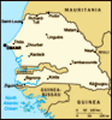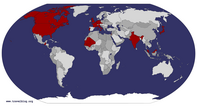Advertisement
Published: July 23rd 2010
Well, we survived our last few days in Koungheul, a few horribly long days in Kaolack with no electricity, no water, nowhere to go and nothing to do , and we're now back in lovely Dakar. Things that once seemed so run-down, strange, and dirty to Mom now seem clean, in great condition, and highly advanced after two weeks out in smaller towns. It's all about perspective.
We drove back to Dakar in a taxi in the middle of a ridiculous downpour. I was worried our taxi driver just wouldn't show up to drive us due to the awful weather, but he was just late because the guy who gives out authorization to leave the city overslept. Oh, Senegal. Driving between Kaolack and Dakar is a bit like a video game. You need to dodge the massive potholes, avoid running into other vehicles, try not to pick off goats or cattle, all while driving an ancient car with no working odometer, speedometer, or gas gauge. Oh, and this car apparently had holes in the bottom of it, so when we splashed through giant puddles, my seat (and butt) got really wet. Fun
times!
Two days ago, we went to Ile de Gorée, which was an important port in the slave trade. The Maison des Esclaves (Slave House) saw thousands of the best slaves pass through its Door of No Return. They didn't accept any old, sick, or scrawny slaves, so the slaves that made it through this house were among the best and strongest slaves sent to the New World. You can walk through the cells where they kept the slaves, and you can stand in the doorway of the Door of No Return.
If you can move past the atrocities committed on the island, it is truly a beautiful place. We explored the island with Delfien and Joep, a Belgian couple staying at our hotel. They are super nice and we had a lot of fun with them. We walked all over the island, taking in the gorgeous views, bargaining with artisans, and just appreciating Dakar's top tourist attraction. After eating a delicious meal of kafta
and frites, we caught the early afternoon ferry back to Dakar.
In an attempt to find the office for the Casamance ferry, we ended up getting a tour of the entire Dakar shipping port. . Turns out the office had moved two days before...right next to where we got off the ferry from Gorée. We then explored the Malian market, which is next to Dakar's train station. There is a small commuter train, but the long distance train to Mali hasn't been running for years now. The station is beautiful but in a state of disrepair. Somehow a guy ended up giving us a tour through the Malian market, and we got to see how they make bazin fabric. Turns out the fabric gets its shiny look because guys sit around and pound the fabric with wooden mallets all day long. Very cool. We also saw all sorts of "tools of seduction" (waist beads, jewelry, skin-lightening soaps, incense) , traditional medicine supplies, food (I am NEVER eating dried fish again after seeing it there), and stacks and stacks of shiny bazin fabric. We then walked through Dakar's main
square (there's really nothing to see) past the Presidential Palace and Senate building to get to the Air Mali office. That pretty much covered all there is to see downtown.
Yesterday, we walked to Les Almadies - the super rich part of Dakar full of massive houses and big hotels. This is the furthest point west of continental Africa, so we wanted to walk there just to say we did. The beach there is about two square meters, so we took a taxi to Plage N'Gor instead. We didn't bring our bathing suits, and the beach was really crowded anyway, so we piled into a pirogue (like a giant wooden canoe) and went to Ile de N'Gor instead. After cooling off with some Cokes, we explored the tiny island. . There are no roads and no cars, so we wandered through the tiny paths between houses. There are amazing views of the ocean and les Almadies from the back side of the island, and it was cool and windy up on the cliffs.
It's very hot here, so it's not peak tourist season. This is both good and bad. Good:
things aren't terribly crowded and overrun with other toubabs. Bad: we are serious targets for anybody and everybody selling stuff. . No, I don't want to buy your crappy necklace...I'd really rather drink my pineapple soda in peace. Also bad: It's really sunny, so I am currently sort of maroon. Even when it's cloudy due to rain, I still fry. Despite slathering on sunscreen, I still managed to burn. I need to write a letter to the sunscreen company and let them know that their spf 50 super sweat- and waterproof sport sunscreen is no match for Africa.
Today, we went to le Village des Tortues, which is a little refuge for endangered and abandoned turtles/tortoises. Some of them are so old that they can never be released into the wild. They'll live out the rest of their potential 150 years here in relative peace and quiet, being fed leaves and grass by tourists. The oldest is 102, and the biggest is 220lbs (and
named Bill Clinton). There are some young turtles that will eventually be released, but even that is not a quick and easy process. They start out in the nursery for several years, then they get moved to the juvenile area to gain weight (they have to be at least 8kg before they can be moved to a real enclosure). They don't even begin mating until about age 13, so they have to stick around until at least then. Then once they're all grown up, mating, and taking care of themselves, they'll be released into the wild in northern Senegal. We learned that when turtles get fat, they grow points on their shells. We got our photos taken with an obese turtle who has a shell full points. Poor guy was owned by a wealthy diplomat that overfed him. Now he's on a strict vegetarian diet of carrots, tomatoes, watermelon, and mangoes.
After saying goodbye to the adorable baby turtles (only two months old!), we set off to Lac Rose. The name means Pink Lake, and I always thought the name was a bit of an exaggeration in an attempt to get tourists. But the water is actually really pink!
The algae living in the lake, which gives it its pink color, rises to the surface when it's sunny and windy, so you need to be lucky to see the pink color. We were apparently really lucky and got to see the pink lake in all its glory despite it being the rainy season. The lake is saltier than the Dead Sea, with a salinity of 38%. After floating in the Dead Sea and experiencing how the super salty water can hurt your skin, I wasn't upset that we didn't bring our bathing suits with us. They claim the lake can heal your rheumatism, spotty skin, and hemorrhoids....but only if you spend less than fifteen minutes in the rose colored water!
On the other side of the lake from the touristy area (full of restaurants serving over-priced food and boasting bathing beaches that are tiny and full of shells instead of sand), there is the salt-harvesting section. It's open to anybody to work there, as there is no hourly wage or taxes. People show up and spend nine hours a day in the water, breaking up the crystallized salt with a spear, collecting it in a sieve, and dumping
it in a pirogue (like a wooden canoe/row boat). When the pirogue is full, it will weigh a metric ton (2,200lbs). A good worker can bring in three pirogues a day. That's so much salt that I can't wrap my head around it. The men harvest the salt, and then women unload the pirogues by filling buckets, typically weighing about 60lbs, putting them on their heads and taking them to the designated pile. The rules of the lake are pretty simple: no stealing and no fighting. So, people write their initials or family name on a sign, stick it in the ground, and no one touches their salt. At the end of the day, with three pirogues full of salt, the worker keeps two pirogues worth, and the third pirogue is split between the woman unloading the boat and the owner of the boat. The salt is then sold to a middleman in 50kg (110lb) sacks for roughly $2. That means that once the salt is divvied up, the worker earns roughly $80 after nine brutal hours in the sun and in the salty lake. The work is so physically demanding, though, that the men can only work two days
a week.
Many of the workers (who are always men), come from poorer neighboring countries, like Guinea and Mali. Since they don't have to worry about work visas, taxes, etc, they can work hard for four or five years and take the money home. After seeing how difficult the work is, I can only imagine how horrible the conditions are in their home countries that this would seem like a good alternative.
Other than that, we've picked up our clothes from the tailor and we're trying to pack our bags to head home. Packing is pretty easy when your clothes are so filthy you throw most of them away. Our flight tomorrow is super early. We're getting a taxi at 4am to fly to Lisbon via Casablanca. Inchallah there will be no delays like our flights here!
[Note from Karin: This will be my final blog entry as a co-author. I have to admit that it has been an amazing experience in many ways. I know that the world is full of poverty but to actually see it is another thing. Picture the Sunday morning ads for Feed the Children and they show the horrible living conditions.
That's what it is like here with stagnant water and rotting garbage everywhere while kids play soccer with a makeshift ball beside it. I have been fortunate to travel "Kate style" and to realize that the only difference between us and the Senegalese people is where we were born. The people have been extremely friendly, kind and welcoming and they truly want to make you happy. Thanks, Kate!]
Advertisement
Tot: 0.182s; Tpl: 0.015s; cc: 13; qc: 78; dbt: 0.1061s; 1; m:domysql w:travelblog (10.17.0.13); sld: 1;
; mem: 1.3mb























sara
non-member comment
great blog!
Hi Ladies! Thanks for the great blogging, and for sharing your amazing experience. I enjoyed reading your updates and seeing your photos, and sharing the experience with you both. I want to travel "Kate style" - where do I sign up?!? (Perhaps a trip to Timbuktu next year???)